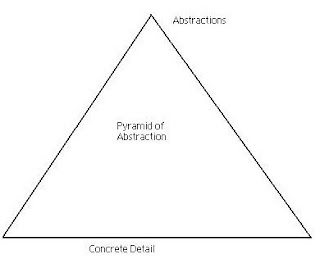Garren Jacobsen
 Auror
Auror
I attended a class taught by Brandon Sanderson. In that class, he talked about improving your prose and making readers feel more engaged. To do that he gave us the example of the pyramid of abstraction, shown below. He says that there is a scale to writing. On the one end is abstraction, on the other end, is concreteness. To illustrate what is and is not abstraction he talked about two words, love and dog. He asked us whether the concept of "love" is abstract, it is. To say that I love you is something fairly abstract since everyone has a different take on what love is. He then asked us whether the word dog is abstract. He said that it was because we all have a different conception of what a dog is, meaning we imagined different breeds and such as well as states of being.
In order to be concrete, the concept or action needs to be set in a scene. Take the dog example. To make it become concrete, you describe the dog in detail. You describe its breed, color, whether it is wet or dry, its size, its look, what it smells like, how it walks, etc. The problem becomes making he prose be more concrete. This requires actions and, oddly enough, having the reader draw conclusions about the actions.
Interested in your thoughts.

In order to be concrete, the concept or action needs to be set in a scene. Take the dog example. To make it become concrete, you describe the dog in detail. You describe its breed, color, whether it is wet or dry, its size, its look, what it smells like, how it walks, etc. The problem becomes making he prose be more concrete. This requires actions and, oddly enough, having the reader draw conclusions about the actions.
Interested in your thoughts.



 Inkling
Inkling Myth Weaver
Myth Weaver